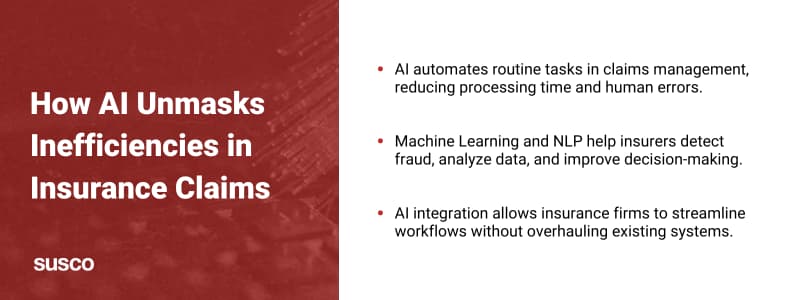Learn how artificial intelligence is preventing fraud and streamlining workflows in insurance claims processing.

AI is revolutionizing the insurance industry by identifying and addressing inefficiencies, particularly in claims management. The traditional claims process is often riddled with manual workflows, redundant tasks, and error-prone procedures, leading to increased costs and delays.
AI-powered technologies, such as ML and NLP, offer innovative solutions that streamline processes, reduce operational costs, and improve accuracy.
How AI transforms claims management, making the process more efficient and effective for insurance adjusters and firms, isn’t magic. It’s good old-fashioned hard work.
Current Challenges in Insurance Claims Management
Insurance claims management faces inefficiencies that create delays, increase costs, and reduce accuracy. Many firms still rely on outdated manual processes that slow claims handling and introduce errors. Redundant administrative tasks consume valuable time and drive up labor costs, making claim resolution resource intensive.
Fraudulent claims further complicate insurance workflows. Adjusters must spend significant time identifying and investigating suspicious claims, which delays legitimate payouts. Additionally, claims data exists in multiple formats, including scanned documents and emails, making it difficult to process efficiently.
AI Techniques Transforming Insurance Claims Management
AI is revolutionizing insurance claims management by improving accuracy, efficiency, and fraud detection. Traditional processes rely on manual verification, which can be time-consuming and error-prone.
Integrating AI technologies such as ML and NLP automates key tasks, analyzes large datasets, and more effectively identifies fraudulent patterns. These advancements result in faster claims processing and better decision-making.
ML for Smarter Decision-Making
ML algorithms analyze historical claims data to predict outcomes, detect anomalies, and optimize resource allocation.
By recognizing patterns in claims history, ML helps insurers estimate settlement amounts with greater accuracy. It also identifies inconsistencies that may indicate fraud, flagging high-risk claims for further investigation.
NLP for Better Data Management
NLP enables insurers to process unstructured data from various sources, such as emails, scanned documents, and claim forms.
AI-driven systems extract key information, reducing the need for manual data entry. NLP-powered chatbots improve customer interactions by handling inquiries and updating claim statuses efficiently.
AI’s Role in Fraud Detection
AI is crucial in minimizing fraudulent claims by identifying suspicious behaviors and anomalies. By analyzing vast amounts of claims data, AI detects exaggerated damages, duplicate claims, and inconsistencies that human adjusters might overlook.
Cross-referencing claims against industry databases enhances fraud detection efforts, ensuring that genuine claims are processed promptly while fraudulent activities are curtailed.
AI-driven technologies are transforming claims management by enhancing efficiency, reducing errors, and detecting fraud with unprecedented accuracy. Insurers leveraging ML and NLP can streamline operations, cut costs, and deliver a better experience for policyholders.
Benefits of AI in Claims Management for Insurance Adjusting Firms
AI is reshaping claims management by increasing efficiency, reducing costs, and improving accuracy.
Manual tasks that once consumed hours of labor can now be automated, allowing adjusters to focus on more complex and high-value cases.
Automating Routine Tasks
AI-powered systems handle administrative duties such as data entry, documentation, and initial claim assessments.
By automating these repetitive processes, insurers can eliminate bottlenecks and ensure that adjusters spend time analyzing claims rather than handling paperwork. This reduces human error and expedites claim resolution.
Reducing Processing Time and Costs
By integrating AI into claims management, insurers can significantly reduce processing delays.
Automated workflows streamline approvals, verifications, and settlements, reducing the need for excessive manual intervention.
Enhancing Accuracy and Fairness
AI-driven data analysis minimizes inconsistencies and improves the precision of claim evaluations.
Advanced algorithms analyze claims against historical data and industry benchmarks to ensure fair and accurate settlements. This approach reduces disputes and enhances customer trust in the claims process.
AI continues to redefine insurance claims management by making processes smarter, faster, and more accurate.
As insurers embrace these technologies, they gain a competitive edge while improving overall operational effectiveness.
Overcoming Data Challenges with AI
Integrating AI into insurance claims management presents challenges, particularly in handling unstructured data and adapting to legacy systems.
Many insurers operate with outdated infrastructures that were not designed for AI-driven automation.
Transforming Unstructured Data into Actionable Insights
Insurance firms deal with data from various sources, including handwritten documents, emails, and scanned records.
AI-powered data extraction tools convert unstructured information into structured formats, making it easier to analyze and process.
NLP techniques refine data accuracy by interpreting language nuances, allowing insurers to extract relevant details automatically.
These advancements reduce reliance on manual data entry and improve claim assessment accuracy.
Integrating AI with Legacy Systems
Many insurance companies hesitate to adopt AI due to compatibility concerns with legacy systems.
AI-driven middleware solutions bridge this gap by enabling seamless communication between new AI tools and existing infrastructures.
These integrations allow insurers to leverage AI without overhauling their entire system, making implementation cost-effective and minimally disruptive.
Scaling AI Solutions for Future Growth
AI adoption in insurance must be scalable to accommodate future data needs and regulatory changes. Cloud-based AI platforms provide insurers with flexible, scalable solutions that can handle growing volumes of claims data.
By implementing adaptive AI models, firms ensure long-term efficiency improvements and maintain compliance with evolving industry standards.
AI effectively addresses challenges in insurance claims management by transforming unstructured data, integrating with legacy systems, and providing scalable solutions.
By adopting AI-driven tools, insurers can enhance efficiency without disrupting existing operations. As the industry continues to evolve, leveraging AI will be essential for firms looking to stay ahead in an increasingly digital landscape.
AI is reshaping the insurance claims landscape by improving efficiency, reducing costs, and enhancing accuracy. As insurance firms strive to modernize their processes, leveraging AI-driven technologies is no longer an option but a necessity.
Susco Has Solutions
Is your insurance firm ready to embrace AI-powered claims management?
Contact Susco Solutions today to learn how our cutting-edge AI solutions can transform your claims processing workflow and drive operational excellence.